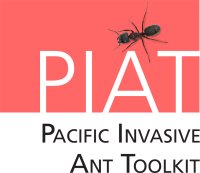Advanced detection tools
Remote sensing for red imported fire ant
Pioneered by Australia's National Red Imported Fire Ant Eradication Program, remote sensing uses aerial imagery to detect red imported fire ant (RIFA) mounds.
A camera that can take pictures in three spectra, the visual, near infrared and thermal, is mounted on the underside of a helicopter, which flies over the target area at a height of 150 m.
Mounds are detected based on the lower vegetation cover and higher temperatures of RIFA mounds relative to the surrounding areas. During cooler weather, RIFA mounds may be up to 10°C warmer than the surrounding ground!
This method of surveillance drastically increases the area being surveyed and decreases the cost of surveillance. For example, a single helicopter and camera can survey more than 750 ha/day, while a 10 person team can survey around 10 ha/day. It can also easily survey areas that may be difficult or dangerous for ground teams to access. This method requires fine, dry weather to operate and must be done in the cooler months so there is a contrast in temperature between the ground and the RIFA mounds.
|
A remote surveillance helicopter at work (© The State of Queensland, Department of Agriculture and Fisheries, 2016) |
Biosecurity Queensland describes how they use remote sensing to combat the red imported fire ant, YouTube video (© Biosecurity Queensland) |
Odour detection dogsOdour detection dogs are trained and used to detect the unique scent (pheromones) of a specific invasive ant species (detection dog video). The idea was first developed and put into action by the National Red Imported Fire Ant Eradication Program in 2006 in Australia to detect RIFA in Queensland and New South Wales. Since then detection dogs have been trained to detect little fire ants and browsing ants in Australia, Argentine ants in New Zealand and RIFA in Taiwan. These dogs are mainly used to verify that ant colonies have been eliminated after treatment. Detecting the last 1% of surviving ants after treatment is the most difficult part of an eradication and detection dogs have proven to be a very accurate and cost effective way to do this. A preliminary study in New Zealand suggests that detection dogs are 5 times more cost effective at surveillance than the use of large-scale baiting grids. |
Rhys Jones, the New Zealand Argentine ant detection dog (© Darren Ward) |
Information sources
ABC News, Red imported fire ants, Queensland
ABC News, Red imported fire ants, Gladstone
The Conversation, Red imported fire ants
Lach, Barker. 2013. Assessing the effectiveness of tramp ant projects to reduce impacts on biodiversity. A report prepared for the Australian Government Department of Sustainability, Environment, Water, Population, and Communities
Lin, Chi, Lin, Tseng, Chen, Kung, Lien, Chen. 2011. Fire ant-detecting canines: a complementary method in detecting red imported fire ants. Journal of Economic Entomology 104(1): 225-231
Minister for Agriculture and Water Resources, Browsing ant
New Zealand Herald, Argentine ant
Ward, Toft, Cook, Shields, Jones, Waipara. 2014. A "sniffer" dog to detect Argentine ants. Protect Spring 2014: 15-16


